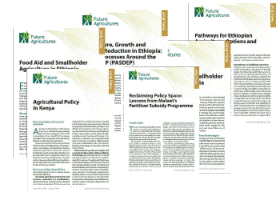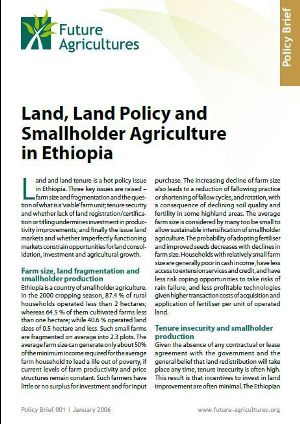Policy Briefs
The Policy Brief series was launched by Future Agricultures in 2005 to provide a forum for the analysis of important agriculture policy issues by leading researchers. The series aims to identify key issues, apply the best and most up-to-date research to help understand these issues, and explore the implications of this research for the design and conduct of policy. We typically publish between 8 to 10 Policy Briefs each year.
A significant number of our policy briefs are also translated into French.

Latest articles
Future Scenarios for Agriculture in Malawi: Challenges and Dilemmas (ii) policy
January 9, 2006 / Policy BriefsPolicy Brief 09
By Ephraim W. Chirwa, Jonathan Kydd and Andrew Dorward
This Briefing Paper examines challenges and dilemmas for Malawi’s agricultural policy-makers, emerging from current policy processes as well as being rooted in past policies and outcomes.
Future Scenarios for Agriculture in Malawi: Challenges and Dilemmas
January 8, 2006 / Policy BriefsPolicy Brief 08
By Ephraim W. Chirwa, Jonathan Kydd and Andrew Dorward
January 2006
Malawi is one of the poorest countries in the world, with per capita gross domestic product of $190 and high rates of child malnourishment and infant mortality. More than half the population lives below the poverty line, with almost a quarter on the verge of survival. Agriculture plays an important role in the economy. The sector performed well in the first two decades since Independence in 1964, but subsequent performance has been disappointing.
Agriculture Policy Processes in Kenya
January 7, 2006 / Policy BriefsPolicy Brief 07
By Patrick O. Alila and Rosemary Atieno
January 2006
The success of Kenya’s Strategy for Revitalising Agriculture (SRA), discussed in the Future Agricultures briefing Agricultural Policy in Kenya, depends critically on policy processes, structures and actors affecting agricultural policy in Kenya. This briefing examines the impact of each of these factors on Kenyan agricultural policy-making, both historically and in the present. It situates the various policy-making, ‘nodes’ within the SRA framework and considers whether or not these structures and processes are sufficient for implementation of the SRA.
Agricultural Policy in Kenya
January 6, 2006 / Policy BriefsPolicy Brief 06
By Patrick O. Alila and Rosemary Atieno
January 2006
Agriculture is the backbone of the Kenyan economy. It contributes approximately 25% of GDP, employing 75% of the national labour force. Over 80% of the Kenyan population live in rural areas and make a living, directly or indirectly, from agriculture.
The sector is important for poverty reduction since the most vulnerable groups, such as pastoralists, the landless, and subsistence farmers, depend on agriculture as their main source of livelihoods. Growth in agriculture therefore can be expected to have a significant impact on a larger section of the population than any other sector. Likewise, policies affecting the performance of agriculture have important implications for the economy as a whole.
Agriculture, Growth and Poverty Reduction in Ethiopia
January 5, 2006 / Policy BriefsPolicy Brief 05
By Amdissa Teshome
January 2006
Trade-offs between growth and poverty reduction and the role of agriculture are major contemporary issues in debates about future agricultures in Africa. In Ethiopia, this has been a long-running debate, but one that has been brought into sharper focus by the recent discussions about the second PRSP (Povery Reduction Strategy Paper) –the Plan for Accelerated and Sustainable Development to End Poverty (PASDEP). This briefing explores the policy processes surrounding PASDEP, and the implications this has for agricultural policy and rural development more broadly.
Intensification of Smallholder Agriculture in Ethiopia
January 4, 2006 / Policy BriefsPolicy Brief 04
By Samuel Gebreselassie
January 2006
The prevailing orthodoxy is to see the problem of smallholder agriculture in Ethiopia strictly as a technical and resource related problem. This view identifies the low level of agricultural productivity as the key problem. In response, the government of Ethiopia has since the mid-1990s, implemented a high-profile, national technology-led extension programme. But has this worked, and what are the limitations of such a strategy
Food Aid and Smallholder Agriculture in Ethiopia
January 3, 2006 / Policy BriefsPolicy Brief 03
By Samuel Gebreselassie
January 2006
Ethiopia has been structurally in food deficit since at least 1980. Today, Ethiopia is the world’s most food aid dependent country. The country received 795 thousand metric tonnes of food aid annually between 1990 and 1999, about 10% of total domestic grain production. This Briefing asks what have been the impacts of food aid in Ethiopia and what are the implications for future policy, and particularly the links between food aid and smallholder agriculture?
Pathways for Ethiopian Agriculture: Options and Scenarios
January 2, 2006 / Policy BriefsBy Samuel Gebreselassie, Amdissa Teshome, Stephen Devereux, Ian Scoones, and Kay Sharp
Policy Brief 002
The paradox facing agricultural policy in Ethiopia was neatly encapsulated in a statement by Prime Minister Meles Zenawi, in 2000: “The agricultural sector remains our Achilles heel and source of vulnerability. … Nonetheless, we remain convinced that agricultural-based development remains the only source of hope for Ethiopia.
” The reality is that most Ethiopians continue to struggle to make their living from smallholder farming, despite low returns, high risks, and the evident inability of agriculture to provide even a reliable subsistence income, let alone a ‘take-off’ to poverty reduction and sustainable economic growth.
Policy-makers and analysts, both national and expatriate, have vacillated between arguing for increased investment in smallholder farming, commercialising agriculture, or abandoning unviable smallholder agriculture by promoting diversification or urbanisation instead. It is often remarked that, if Ethiopia can solve the profound challenges facing its agriculture sector, the lessons will be applicable in many other parts of Africa.
Land, Land Policy and Smallholder Agriculture in Ethiopia
January 1, 2006 / Policy BriefsBy Samuel Gebreselassie
Policy Brief 001
 Land and land tenure is a hot policy issue in Ethiopia. Three key issues are raised – farm size and fragmentation and the question of what is a ‘viable’ farm unit; tenure security and whether lack of land registration/certi. Cation or titling undermines investment in productivity improvements; and finally the issue land markets andwhether imperfectly functioning markets constrain opportunities for land consolidation, investment and agricultural growth.
Land and land tenure is a hot policy issue in Ethiopia. Three key issues are raised – farm size and fragmentation and the question of what is a ‘viable’ farm unit; tenure security and whether lack of land registration/certi. Cation or titling undermines investment in productivity improvements; and finally the issue land markets andwhether imperfectly functioning markets constrain opportunities for land consolidation, investment and agricultural growth.
Farm size, land fragmentation andsmallholder production
Ethiopia is a country of smallholder agriculture. In the 2000 cropping season, 87.4 % of rural households operated less than 2 hectares; whereas 64.5 % of them cultivated farms less than one hectare; while 40.6 % operated land sizes of 0.5 hectare and less. Such small farms are fragmented on average into 2.3 plots. The average farm size can generate only about 50% of the minimum income required for the average farm household to lead a life out of poverty, if current levels of farm productivity and price structures remain constant. Such farmers have little or no surplus for investment and for input purchase.
The increasing decline of farm size also leads to a reduction of fallowing practice or shortening of fallow cycles, and rotation, with a consequence of declining soil quality and fertility in some highland areas. The average farm size is considered by many too be small to allow sustainable intensi. Cation of smallholder agriculture. The probability of adopting fertilizer and improved seeds decreases with declines in farm size. Households with relatively small farm size are generally poor in cash income, have less access to extension services and credit, and have less risk coping opportunities to take risks of rain failure, and less profitable technologies given higher transaction costs of acquisition and application of fertiliser per unit of operated land.
